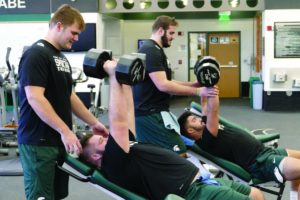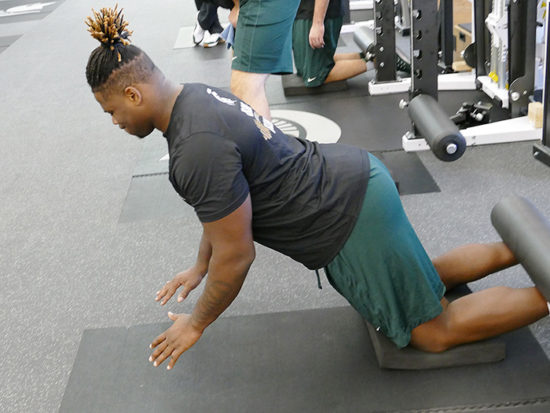Powerline: Staples in strength training
Information overload is the new normal, and we have to deal with it on a daily basis in all aspects of life. The influx of data on safe, productive and sensible strength training is certainly no exception. There’s no dearth of research, suggestions, opinions and methodologies in the strength training arena. Trying to decipher all of this can be daunting.
 I recommend that coaches come back to center to clearly define what’s really important. If your bottom line is that you’re charged with training large groups of young athletes under the internal stresses of limited time, scheduling conflicts, resources and equipment, you need to focus on priorities.
I recommend that coaches come back to center to clearly define what’s really important. If your bottom line is that you’re charged with training large groups of young athletes under the internal stresses of limited time, scheduling conflicts, resources and equipment, you need to focus on priorities.
Embrace the ‘bottom line’
Everyone wants to provide their athletes with the safest and most effective strength training program possible. However, as we go through this process, we must never lose sight of the fact that training components are but one variable of our players’ total development.
For example, while there are many similarities and common objectives among powerlifters, Olympic lifters and athletes who are not engaged in competitive lifting, there are also a host of differences. In sports outside of competitive lifting, athletes use strength/weight lifting and a wealth of other procedures, modalities and techniques as a means to end — not as an end in themselves.
Time-efficient protocols are crucial to day-to-day operations — especially at the high school level — as athletes invest time in other drills, film study and overall skill enhancement. The take home point is that coaches must examine, dissect and determine which approach best fits their needs and allows for the most productive results.
Systematic, progressive overload
Progressive overload is one of the key constituents to power enhancement, muscle growth and strength development. The primary goals of physical training are to systematically magnify the physiological systems of the body, which include the muscular, connective tissue, neural and metabolic networks.
Physical development is an adaptation to intense physical work. The intensity of the prescribed exercise must be sufficient enough to place safe and productive stress on the targeted system. With time, these intermittently applied stresses result in adaptation.
The overload principle dictates that once a system has adapted to a workload, the workload must then be increased in a progressive manner for continual adaptations to occur. These adaptations to exercise-induced stress occur during the recovery phase, not during training itself. Therefore, the overload principle demands an adequate period of system recovery between training sessions. Failure to do this may result in the athletes experiencing a catabolic state, where growth and development are hindered or stalemated.
During the course of an offseason training week, there should be a minimum of two days designated as “off-days” for recovery and rejuvenation.
Volume considerations
Recommendations on the total set volume of a workout are wide and varied. Some speculate that volume should increase exponentially with the experience of the trainee. One such recommendation we’ve seen is as follows:
- Beginners: One to three sets per exercise for the targeted area.
- Intermediate level athletes: Three to five sets per exercise for the targeted area.
- Well-trained athletes: Five to six sets per exercise for the targeted area.
- Elite athletes: Seven or more sets per exercise for the targeted area.
Speculations and opinions abound for concomitantly increasing volume with experience, and the rationale may have some degree of credence. However, there doesn’t seem to be a clear consensus on all of the specific neuromuscular, morphological, histological and biochemical requirements of such a recommendation.
 We know that some fairly profound neural and tissue adaptations take place early in the process, along with the acquisition and encoding of lifting skills, which account for much of the initial progress beginner and intermediate level athletes experience.
We know that some fairly profound neural and tissue adaptations take place early in the process, along with the acquisition and encoding of lifting skills, which account for much of the initial progress beginner and intermediate level athletes experience.
Coaches should be able to justify the physiological need for performing a high-volume workout. A workout of that magnitude could require an astounding 35 sets or more, depending on how many exercises are chosen.
Three questions to ask yourself:
- What are the priority movements for the session?
- How many warm-up sets and work sets per exercise are scripted?
- How much time is allotted for the training session?
An approach we adopted in delegating volume guidelines is to make a determination on how many total work sets we want to execute in a given session. Taking that viewpoint, as opposed to focusing on how many sets of a particular exercise, gives you the flexibility of architecting a variety of functional scripts. It also allows you to designate a larger percentage of the total work sets to your primary movements for that day.
Repetition replication
Short-rep duration (fast speed) or longer-rep duration (moderate to slower speed) — what constitutes a proper repetition? I’m not sure the answer is set in stone.
There’s no question that the Olympic-style movements require a certain degree of technique-controlled acceleration. Otherwise, it would be impossible to complete the lifts. Many other movements not only do not require this acceleration component, but doing so may be counterproductive.
Whatever rep duration you prefer, just keep in mind that proper technique is critical to both safety and accruing the expected outcomes. The important factor is to keep all the reps in a given set relatively standard in rep speed and as close to identical in technique. This is called “rep replication.”
We tell our athletes that if the weight selection is correct, they should lift the weight with as much force as is needed to complete the raising phase of the repetition with excellent technique. We use the term “controlled explosion,” which sounds contradictory, but it signals our insistence on force production and the use of appropriate weight for the given rep target or range. For the most part, we want to create and maintain as much tension within the working musculature as possible; therefore, the correct weight load is a prime requisite.
Depending on the movement, a slight pause at the mid-range position should be in effect to allow for a smooth transition into the lowering phase of the movement. Lowering the weight in a controlled fashion sustains the tension within the target musculature for a more productive set.
Whatever rep duration is required or expected, just be sure that technique is as close to perfect as possible, and that all other safety considerations have been thoroughly taught.
Ken Mannie is the head strength/conditioning coach at Michigan State University. To contact him about this topic or anything else you’ve read in Powerline, send him an email at [email protected].
For previous installments of Coach & Athletic Director’s Powerline, click here.
TIP FROM THE TRENCHES: Story telling for developing team pride and establishing standards
As strength and conditioning coaches, we spend a great deal of time with the athletes. Doing so affords us the opportunity to drive home messages on discipline, character, accountability and integrity.
At Michigan State, we tie-in the meaning and significance of our Spartan namesake, the passage Iron Sharpens Iron (Proverbs 27:17) and the Marine Corps manifesto when discussing the team first and earn-the-jersey mentality we demand from players. We want accountability, toughness, effort and unity as the order of each and every day.
Iron Sharpens Iron, with everything the term embodies in living a life of service and outreach to others, is also a profound statement on the strength of a team. “As iron sharpens iron, so must we sharpen each other.”
Greek historian Herodotus said, “The Spartans, when they fight individually, are as good as any. But when they fight as one, they are the best soldiers in the world.” The Spartan fighting formation, the phalanx, was a meticulously architected formation with the objective of bringing a powerful, impenetrable force to the battlefield. The Spartan shield was designed to protect half of the bearer, and half of the man to his left. If there was any gap or crease in the phalanx, your brothers in arms were put at risk. If a Spartan came back from battle without his helmet, he was fined. If he came back without his shield, he could be banished from Sparta. Hence the battle cry, “Come back with your shield, or on it,” which was the final, stern send-off message from mothers and wives of Spartans going battle.
The Marine Corps Manifesto, which is posted in its entirety in our weight room, has this profound line in it: “You will be measured not by how much you have, but by how much of yourself you are willing to give.” We want to replicate those sentiments in our mental, physical and emotional development as Spartans. In essence, you will “earn the jersey” here at Michigan State University, for it’s truly a privilege to wear the Spartan green and white.


